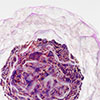| Dec 14, 2021 |
|
|
|
(Nanowerk News) During clinical research, cell cultures help test new drugs, determine the correct dosage of active substances, and better understand processes in the human body. Until now, we have mostly used cell cultures growing in a single layer on a culture medium.
|
|
However, current research results show that cell cultures that grow in three-dimensional forms can, in fact, answer many questions better and more realistically than conventional cell cultures.
|

In a new white paper (“OCT for 3D cell culture visualization”; free download), the Fraunhofer Institute for Production Technology IPT in Aachen describes the challenges of working with 3D cell cultures and how optical coherence tomography (OCT) can be used to reliably visualize 3D cell cultures.
Cell cultures that grow in a three-dimensional form offer clear advantages for drug research: due to their higher complexity compared to simpler single-layer cell cultures, they better represent the actual conditions of the human body. This opens new opportunities, particularly in drug research: between 88 and 95 percent of all drugs in clinical trials never reach the market because the results of tests on 2D cell cultures cannot be reproduced in clinical trials.
Because 3D cell cultures can better replicate the processes within the human body, they create a more realistic environment for drug testing. This could bring more drugs to the market in the future, significantly reducing the development costs.
The visualization of 3D cell cultures
|
|
In their new white paper “OCT for 3D cell culture visualization”, the Aachen researchers describe the challenge of visualizing 3D cell cultures. The volumetric cultures have strong scattering properties and can reach a diameter of up to several millimeters. However, their greatest informational value lies below the surface.
|
|
Previous methods, which include thin sectioning, fluorescence light sheet microscopy, confocal laser scanning microscopy and 2-photon microscopy, are time-consuming, technically demanding and error-prone. However, the main disadvantage of these state-of-the-art techniques is the fact that they are all invasive, i.e., destructive. This results in increased resource requirements and makes long-term studies of a single 3D cell culture impossible.
|
An alternative approach: optical coherence tomography
|
|
A new approach for the imaging 3D cell cultures is the imaging technique of optical coherence tomography, which is presented in the white paper: OCT originates in ophthalmology and can generate high-resolution cross-sectional images.
|
|
It works completely contact-free and best of all, it is non-invasive. This makes it possible to examine 3D cell cultures and their growth patterns without conducting further handling processes, media changes or preparation cuts. Like all other optical methods, OCT is limited in its penetration depth. Therefore, current research projects in which OCT is used to visualize 3D cell cultures mostly focus on small 3D cell cultures with a maximum diameter of 500 µm.
|
OCT as an opportunity to visualize 3D cell cultures
|
|
The white paper explains the potential of OCT as a fast and non-invasive technology for visualizing 3D cell cultures, highlights its usual limitations, and describes approaches to overcome existing limitations such as its limited depth measurement range. In addition, further automation of OCT systems could open up for its wider use in laboratory applications.
|
|
“Our goal is to prepare the OCT technology for the laboratory of tomorrow and to incorporate digital and automated subcomponents. We would like to draw attention to these opportunities with this white paper,” explains Enno Hachgenei, group manager of the Optical Metrology and Imaging Methods group at the Fraunhofer IPT.
|


